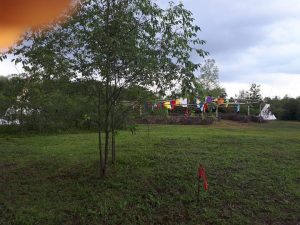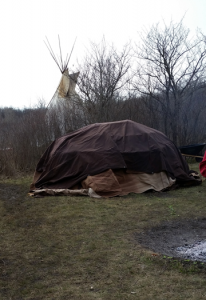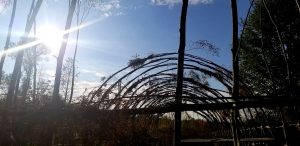Week 8: Ways of Knowing Bzindamowin — Learning by Observing Someone
Ceremonies and Teachings
Midēwiwin Lodge
The Midēwiwin, also known as the Grand Medicine Lodge, is one of the oldest Anishnaabeg traditions. The story of its beginning goes back to the earlies days when the Anishnaabeg lived on the Atlantic seaboard. It flows out of the Seven Grandfather Teachings. The following is the account of the first Midēwiwin Lodge and ceremony.1
The people did not know how to live in harmony with creation. Many were sick, and many did not recover. Nanabozoo tried to help but was unsuccessful. So he tutored a young boy for seven years, teaching him about the universe. Then Nanabozoo took the little boy to the lodge of the Seven Grandfathers. They are powerful spiritual beings. The Seven Grandfathers took the little boy in and gave him the gifts of the Seven Grandfather teachings and many other teachings. When the little boy returned to the people, he was old. He lived among them, teaching them spiritual truths and how to seek them as in the Vision Quest.
In time the old man took on a young boy as an apprentice. He began to teach him the things he had learned while with the Seven Grandfathers. One day the boy fell ill. Death looked imminent. He asked the women to build a lodge as he instructed them. He asked the women because they represented the life-giving force of the earth. The lodge was built running from east to west with an eastern door. The old man was given a vision of the tree of life, and he had one placed inside the lodge. He also set a sacred megis shell at the doorway to the lodge. The old man received instructions on how to construct the water drum. When all was ready, the little boy was placed in the lodge.
The ceremony began with the old man sounding the water drum four times. The ceremony continued all day, and as the day wore on, the little boy began to gain his strength. By the end of the day, the little boy had recovered.
Viewing Assignment 1
Reading Assignment 1
The Four Degrees2
Today the Grand Medicine Lodge is enjoying a resurgence. One may not apply to become a member of the society but must be invited. Lodge members will look for community members that are upstanding and gaining in wisdom, and one will ask that community member to join. If they accept the invitation, they are assigned a tutor, and then they must undergo a rigorous initiation rite. There are four stages called degrees a candidate must go through to gain full membership. In a few locations, the number of degrees is eight.
The tutor will teach the candidate a couple of times a week during the first year. He must learn the medicinal plants and the chants and songs that go with each one. Then the Midēwiwin Lodge will hold a First Degree ceremony at the end of the first year. Five days before the ceremony, the candidate will build a lodge for himself away from the community. He will fast and pray for the next four days, preparing for the ceremony.
The Midēwigun or lodge is built, running east to west. The eastern door entrance is at the east end of the lodge, where a sacred megis shell is placed. A cedar post is placed in the lodge as the tree of life. A sacred fire or Midēwatik is lit beside the tree of life. The candidate is escorted to the lodge by his sponsor, enters the Midēwigun, placing his offerings at the tree of life, and the First Degree initiation rite begins.
If the candidate moves on to the Second Degree, he will be assigned another tutor to instruct him weekly. He then spends the next year collecting his offerings and mastering the medicinal plants, songs and chants. He then prepares for the Second Degree initiation rite as he did for the First Degree. The only difference in the Midēwigun is the second Tree of Life placed near the first one.
To move on to the Third Degree, the candidate must find another tutor to instruct him. When the period of his instruction ends, the candidate prepares the same way as the first two degrees. The lodge is also constructed in the same way, except the third Tree of Life is added. The Fourth Degree initiation is done the same way as the other three, except the Midēwigun has three purification lodges added to the outside of each side of the lodge. The inside has another post added to make four Trees of Life.
The Fourth Degree Midē must now live a life exemplified by the Midēwiwin Code. He must help others, do good works and live the mino-bimaadiziwin or good life.
Sundance Lodge

The Sundance Lodge is a part of the Midēwiwin Lodge. The Western Ojibwe were first to practice it in Manitoba but has since branched out into Ontario. The Sundance Ceremony takes place in July for five days. The Sundance men construct a large arbour and place the tree of life in its centre. A sacred fire is lit outside the arbour at its entrance. Along the inside edges of two sides of the arbour are stalls where the dancers lay their groundsheets for sleeping. The women dancers sleep in one of the stalls while the men dancers sleep in the other. Dancers dance all day, every day. The Sundance grounds are divided in half, with one side for the women and the other for the men.
The whole ceremony consists of multiple rites such as Flying with the Eagles and Walking with the Buffalo. Other rituals are interspersed throughout, like naming ceremonies, smudging and dances.
The Flying with the Eagles ceremony requires cords to be tied to the top of the Tree of Life. The length of the lines is such that they reach the arbour entrance when stretched tautly. The supplicant then undergoes a rite called piercing, where small skewers or needles are pierced through the flesh of the upper chest. The cords are then attached to the pins. The supplicant then moves from the entrance to the Tree of Life, holding it while praying. He then moves back to the opening of the arbour. He repeats this four times, and on the last time, he does not stop when the cords are taut but keeps moving backward until the skewers rip free from his chest. The supplicant submits to this ritual to offer the only thing in this world he owns, his body, to the creator as a sacrifice.

Walking with the Buffaloes is another ritual within the Sundance. Skewers are inserted into the flesh of the participant’s back with cords tied to the pins. The other end of the lines is attached to a buffalo skull. The skull is attached to a second skull. The second one is attached to a third until there are seven skulls. The supplicant then drags the seven skulls around the outside of the perimeter of the arbour.

Viewing Assignment 2
Viewing Assignment 3
Viewing Assignment 4
Ceremony – Sweat Lodge (Madoodison)

The sweat lodge ceremony is a spiritual cleansing and a healing ritual. The lodge represents the womb of mother earth, with each layer of the lodge representing the layers of the universe. The lower layer is the earthly plane, the middle layer is the atmosphere, and the top layer is the starry space. Prayers and petitions pass through the three on their way to the creator.
There is one physical door that always faces east. There are three spiritual doors and the eastern door

through which the spirits pass. Any negativity brought into the lodge by the participants exits the lodge via the western door once the ceremony begins. The firekeeper lights a sacred fire about three hours before the ceremony, and twenty-one rocks, called grandfathers, are heated in the fire until they are red hot. The conductor lays the contents of his sacred bundle on the altar. The altar is located between the fire and the eastern door. The adherents and conductor enter the lodge, close the door flap, and the ritual begins.
The ceremony consists of drumming, singing, chanting, praying and sharing. The conductor will call for more grandfathers as required. The firekeeper passes them through the eastern door. They are placed in a small pit in the lodge’s centre and sprinkled with cedar water. A sweat lodge ceremony usually lasts about three hours.
Viewing Assignment 5
Vision Quest (Makadekewin)
The vision quest is a rite of passage ritual. Usually, supplicants seek their vision at puberty, although many today are adults returning to their traditional ways. The person seeking may be either a male or female. The purpose of the vision is to introduce a person’s spirit guide. The spirit guide will appear during the vision as an animal, bird, fish, or other creature, symbolizing the spirit. The spirit guide’s job is to provide direction and help throughout the adherent’s life.
The person prepares for the quest with a sweat lodge for spiritual cleansing. After the sweat, the adherent will find a place to fast, pray and meditate alone. The person will choose a high site, so the wind is not impeded. The wind is associated with the spirits. The fasting can last up to four days. If the vision doesn’t come, the person may try the vision quest again.
Viewing Assignment 6
Shaking Tent (Jiisakaan)
The Midē performs the shaking tent ceremony to ask the spirits for information or direction. The viewing assignment is long, with very detailed examples.
Listening Assignment 1
Viewing Assignment 7
Teachings
Anishinaabe teachings are much more than teachings but are a way of life. The teachings are given throughout the formative years and reinforced by the parents’ lifestyle and the community. It includes practicing the ceremonies. They become a way of life, Mino-Bimaadiziwin, the good life.
In this lesson, we will only scratch the surface of Anishinaabe teachings to gain a rudimentary understanding of this part of Anishinaabe culture. Teachings are an integral part of the life of the Anishinaabeg. Living the lessons makes teaching experiential rather than instructional. For example, the role of women in the community is known from an early age. Women are the strength of the community. The female’s spiritual power is stronger than the male’s. A woman’s disposition was calmer than a man’s so, her advice was sought after and respected.
Viewing Assignment 8
Seven Grandfather Teachings
Reading Assignment 2
Viewing Assignment 2
Medicine Wheel Teachings
Reading Assignment 2
Other Teachings
Teachings of the Thunderbird
Listening Assignment 1
Teachings on the Pictographs and Tobacco
Viewing Assignment 9 and 10
Colonial Impact
Ojibwe ceremonies, rites and rituals were not impacted with prohibitions in Canada until shortly after Confederation. The Canadian Parliament amended the Indian Act of 1876 in 1880 to ban indigenous people from conducting their spiritual ceremonies such as the potlatch. In 1914 dancing was prohibited off-reserve, and in 1925 it was outlawed altogether. Amendments to the Indian Act deemed these prohibitions criminal offences and punishable by imprisonment. A major revision of the Act in 1951 finally removed this prohibition.
Reading Assignment 3
Questions
- Compare Midēwiwin with the Christianity of the west. What similarities do you see? What differences?
- Do you see similarities or differences between the indigenous ceremonies studied and the Christian sacraments of the Eucharist and Baptism?
- Do the Seven Grandfather Teachings and the Medicine Wheel Teachings differ from the moral and ethical teachings of the west?
[1] The first Midēwiwin Lodge and ceremony adapted from Edward Benton-Banai, The Mishomis Book, University of Minnisota Press, 1988.
[2] For a detailed description of the four initiation ceremonies see Basil Johnston, Ojibway Ceremonies, McClelland Stewart: Toronto, 1976.


